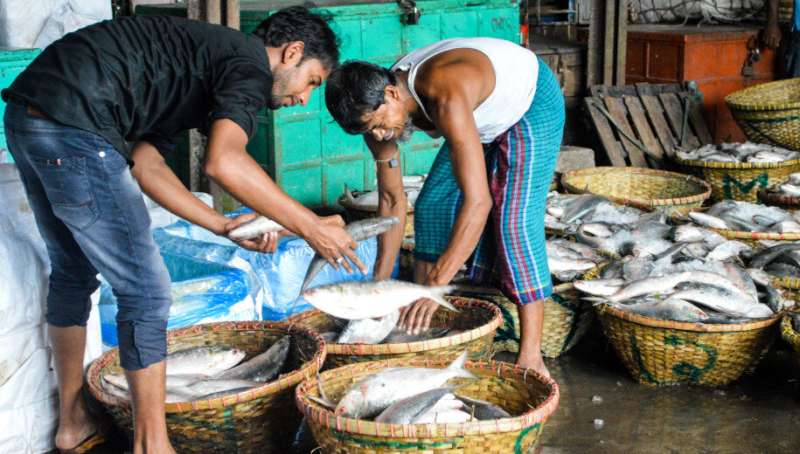Scientific food systems help biodiversity, livelihoods

The extraordinary recovery of stocks of the prized estuarine hilsa (Tenualosa ilisha) fish, following restrictions on fishing imposed by the Bangladesh government, offers a lesson in how a scientifically-managed 'food systems' approach can manage trade-offs between livelihoods and conservation.
Almost 20 years ago, hilsa catches had fallen to a low of 199,000 tons annually, a fraction of the numbers seen in the previous decades, leaving half-a-million fishing families across the country struggling to make ends meet.
As a result of the ban on fishing over 22 days in October during the breeding season and 60 days in March and April to protect young hilsa, stocks are expected to recover to 550,000 tons.
Science-based adaptive co-management during the 2016—2019 period resulted in an average weight gain of each hilsa fish to 915 grams from 510 grams, with the result that the income of fisher households increased by 65 percent, leading to improved livelihood resilience and reduced poverty.
The conservation success story of hilsa that sustains the livelihoods of fishing communities in the Bay of Bengal is bound to be a highlight of the UN Food Systems Summit later this year.
Like many species, including tuna, Indian salmon and tiger shrimp, hilsa numbers had been on the decline, falling prey to a combination of overfishing, rising demand from population growth and pollution.
Hilsa accounts for 12% of Bangladesh's total fish production, contributing to more than one percent of GDP, and earning for itself a position as the country's national fish.
A loss of biodiversity in the northern coastal areas of the Bay of Bengal means a loss of livelihoods, raising the prospect of a fishless zone in the coastal rivers of Bangladesh and its neighbor, India, and an income-less future for families.
Such interdependency between biodiversity, rural incomes and livelihoods required an integrated approach across governments, national authorities, researchers and scientists, and fishers themselves.
At the Consultative Group on International Agricultural Research (CGIAR)'s World Fish, this meant providing the evidence that informed policies to help hilsa stocks recover, while also addressing the needs of families across the bay as part of a dedicated five-year effort.
One key element was to work with authorities to introduce seasonal fishing bans like the one currently in place. The bans allow the hilsa time to migrate from the bay into river estuaries to spawn, and bolster population numbers.
At the same time, it was vital that rural families find alternative sources of food and income. When fewer fish are caught, the women who typically dry, cure and sell them, lose income.
As part of our work, women were encouraged to form community savings groups and helped to access loans that allowed them to diversify their livelihoods. Repayments were suspended during fishing bans to reduce the economic impact on families.
Women can now generate income from alternative activities like tailoring, commercial gardening and rearing goats, cows and poultry during the seasons when the ban is in place.
Working directly with farmers and fishers allowed us to understand their needs and help them to better manage natural resources and avoid the risk of measures to conserve hilsa turning counterproductive by leaving families economically exposed.
Productive assets and technologies were provided to 19,800 hilsa fishing households, which are now fully engaged in sound and sustainable on-farm and non-farm activities that supplement income and nutrition.
Of course, this was no easy task. Both the fishing ban and the support for fishing families had to be carefully synced so one did not undermine the other. And, as with any order or prohibition, there was the challenge of enforcement, and the risk of corruption.
Distributing rice as compensation during the fishing ban periods was difficult, especially to fishing households located in remote coastal areas.
Our experience in Bangladesh was based on a 'food systems' approach which identifies solutions that minimize the competing priorities between different parts of the food system: from production to conservation and nutrition.
Long-term benefits for Bangladesh include information that will optimize the 22-day brood hilsa ban, the allowable mesh size for hilsa gillnets and other scientific data.
Such trade-offs are becoming common as food production needs to be balanced against protection of natural resources and human need for nutritious foods and the livelihoods that agriculture, fisheries and aquaculture provide.
Evidence-based collaborative approaches need to be applied to conservation as a million animal and plant species are being pushed to the brink of extinction and fish stocks fall globally. The recovery of hilsa in Bangladesh offers valuable lessons for the UN Food Systems Summit.
Provided by SciDev.Net


















